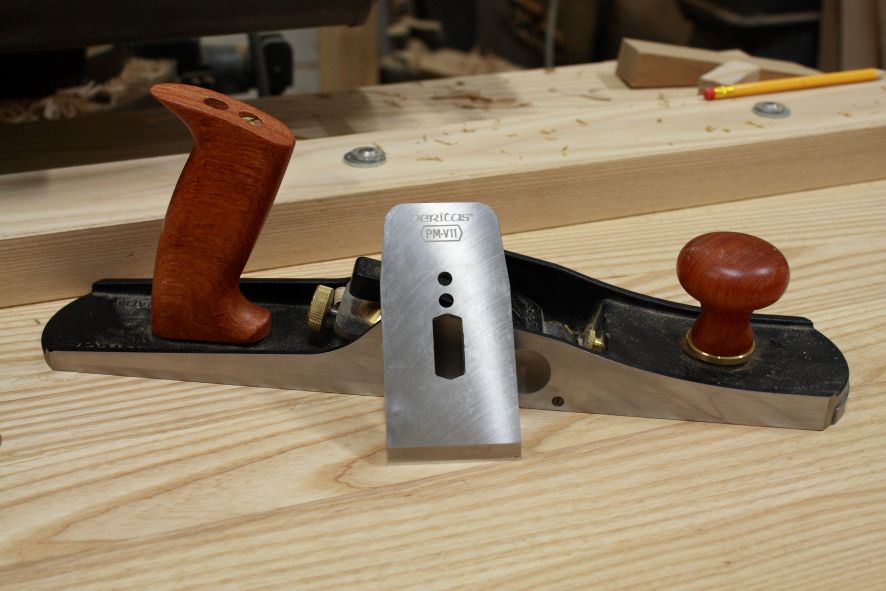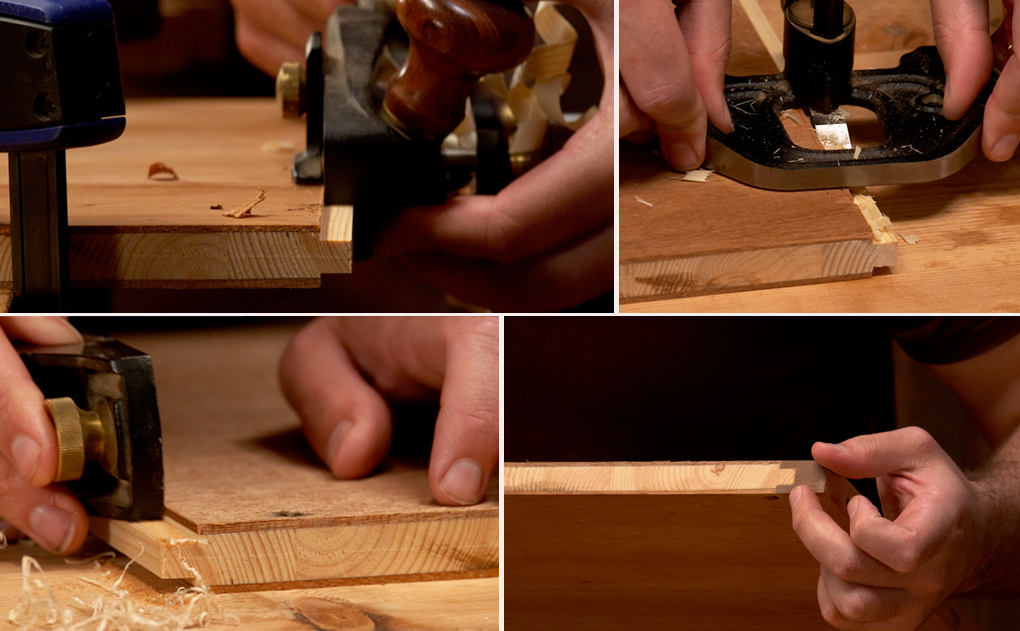I was fortunate enough to get my hands on a new Veritas PM-V11 plane blade last year (the nice chaps at Veritas; Steve and Wally kindly dropped one at my bench at last years European Woodworking Show). That’s a rather technical name and Veritas describe it as an ‘Innovative proprietary alloy’ but most of us only need to know that its an alternative steel for our tools. I’m not sure yet when these blades will be available to buy or what the cost will be.
I’ve had plenty of time to play around with the steel so I thought it could be of interest to share my findings. With there being so many approaches to sharpening I like to keep an open mind to everyone‘s views since the result has got to be more important than the type of steel or method. However to give you a better understanding of my verdict I think you should know that I prefer O1 steel over A2 but really have never been overly picky. I use many old tools, some with edges bodged up from an old hack saw blade or file so that’ll be where my view was moulded. I’m not one to over analyse my tool steels, so long as I can get to work quickly with an edge that will last ok then I’m happy.
I didn’t want to get creative when testing out this new steel. I haven’t put it to use on MDF, concrete or any other obscurity to check its strength. I simply used it for my normal everyday needs as that allows me to give a comparison to my usual experiences.
Since I plane a lot my one tool that never gathers dust are my sharpening stones. With the process being so familiar I noticed the difference in the steel immediately. It didn’t sharpen as quickly as O1 but it felt a lot nicer to sharpen than A2 (I’ve always found A2 to kind of scit across the stones like it has trouble biting).
I put the iron to use in my Jack plane and it’s mainly been used on ash, air dried oak and cherry. Compared with the A2 iron that I am used to in this plane the edge lasted considerably longer, it went twice over my usual sharpening stops and still had a good enough edge to continue. I have to say I’ve been incredibly impressed – with an edge that lasts this long, its well worth the extra time required to sharpen over my usual favourite O1.
As an extra test I took the time to put a nice camber on the edge. This certainly took a long time but it allowed me to give it a good work out as a roughing tool. The edge stood up incredibly well and didn’t nick at all showing it is very hard wearing. When it comes to roughing though I don’t feel it’s worth being so concerned about the sharpness of your tool and I’m happy to remain unfussy on steel choice.
I redressed the edge for a much lighter camber and opted to dedicate this iron for smoothing as that’s where I find it really excels.
I would never go out of my way to replace a perfectly serviceable iron as no steel can revolutionise your woodworking. Should I find myself needing a new plane or iron though then this would be a very welcome option. From a practical perspective its no harder to sharpen than A2 and yet its more durable and lasting, I suppose the only compromise then could come with the price.
One thing I do prefer about A2 and O1 though has got to be the name, PM-V11 isn’t half a bloody gob full!


![Which Saws Are Best For Ripping Thick Stuff? [Video]](https://www.theenglishwoodworker.com/wp-content/uploads/2022/12/what-hand-saw-is-best-for-thick-rip-cuts.jpg)
![How do I Sharpen a Router Plane? [Q & A Video]](https://www.theenglishwoodworker.com/wp-content/uploads/2022/11/how-to-sharpen-a-router-plane-video.jpg)

![Quick Homemade Clamps – Small & Large [with video]](https://www.theenglishwoodworker.com/wp-content/uploads/2022/08/how-to-make-your-own-woodworking-clamps.jpg)
Richard,
Your review of the new PM-V 11 has come at just the right time for me!
I have been looking to buy a new iron for my workhorse Record 4 1/2, but have been unable to reach a decision,is this new iron thicker than a standard iron?
I find the dreadfully thin standard issue iron thickness is one of the main failures of the standard iron, I find it “flutters” when planing anything other than softwood,as my usual wood is very hard old Oak,this gives me a real problem,the new PM-V11 iron is around £60 for the big iron for my 4 1/2,so that is good value!
Chris,
France.
Hi Chris,
What is it with oak? It just gets ridiculously hard when it gets any age to it! I’ve just butted a ruler up to the iron and it looks like 3/16″ thick (about 5mm ish). £60 certainly isn’t cheap but I was expecting it to be a lot more, I think many people will be happy with that.
Thanks, Richard
Hi Richard,
you’ve made one of the most sensible down to earth comments i’ve read regarding plane blades and that’s related to the stage at which your taking shavings from your work…if it’s the earlier stages where your still reducing your stock thickness then there’s a multitude of plane blades that will take shavings perfectly well without worrying about the final finish…infact i might dare go further and say that really the only time you need to truly sharpen any blade to the degree that you would notice the difference is for the final smoothing stages…..grain direction and the most difficult woods too of course….but yeah otherwise a small number of the best blades only for smoothing i think is the way to go.
As for the name PM-V11….blimey it sounds more like a motorbike than a plane blade…..why can’t they personalize the name of blades and make them a little more human…..how about The Veritas Victor…. or Veritas Viper……..Just imagine if you started calling your own beautiful benches names like the Maguire Z111 or C33PO where’s the fun gone!
Still enjoying my own Maguire Workhorse.
Cheers
Steve
Hi Steve,
Nice to hear from you! If most people saw my wooden jack they’d make a strange sigh and a funny face, it looks more like a toothing iron it’s that badly nicked. But it’s got a heavy camber on it and it works perfectly for its intended use. I’m pleased you agree on that point, I think it’s an important skill to understand the intended use of your tools and set them all up accordingly.
Thanks, Richard
Hi Stephen –
The name…. well… there’s a bit of a story there.
Firstly, we needed something searchable for the internet that wasn’t going to return a hairspray, electronic doodad, or some other peripheral item.
The name itself actually does have some pseudo-UK roots. It breaks down this way:
“PM” – for Powder Metal
“V” – for Veritas
and 11 – as Nigel Tufnel said… sometimes, you just have to go to 11….
Cheers –
Rob Lee
Lee Valley, and Veritas
Oh I can’t believe no one replied here.
So I’m asking the question: “Why didn’t they just make the PM-V10 steel harder”
Thanks guys, Rob, Richard, I do love your work. Rob you make absolutely fabulous tools (and tool steels) and Richard you do make a fabulous job in educating the woodworking community! Keep up the good work!
Greetings from Germany
max
Thanks Richard nice review. It’s so refreshing to read, great info no BS. I have the T10 carbon steel blades in my planes, and very happy with them.
Thanks buddy 😉
I was never any good at science so I can’t give the BS 😉
HaHa 🙂
I suppose we all worship at the altar of edge longevity now. I really didn’t know I had a problem until the manufacturers told me I did. Oh well, back to Square 1 I suppose. Now I just need to scratch up some funds.
Hi Charles, I know what you mean, there’s never really a need for anything better but if it can take us one step closer to an everlasting edge then maybe its a step in the right direction 😉
What an appalling thought Richard. All the rhythm and synchronization of the shop, moments to have a chat, cup of tea, etc. would be gone. Don’t know about you but after 30 minutes or so of steady hand-planing I’m ready for a break, a quick hone up and a straightening of the back if not, I hate to say it, a smoke.
Ha ha, I like your thinking. Unfortunatly though its normally just the quick hone up for me, with Helen looming over my shoulder!
It is very true though what you say, hand work isn’t so physically demanding if you get the balance right; a quick rest whilst you sharpen’s all part of it.
I’ve known Leonard Lee since the late 70’s when my father introduced me to Lee Valley. I even brought Toshio Odate to McGill to give a presentation on Japanese tools. Anyway, enough of mine is bigger than yours.
I have a range of planes, mostly Record (including an unused Record 08 I picked from a school in Woking for peanuts – I just look at it very so often since I have another I use)
When it comes to blades – the majority are “Best Crucible Cast Tungsten Steel” and some are unmarked.
I do find sharpening a bit like ironing clothes – a sort of meditative exercise that cleans and refreshes what little soul I have.
But, I wish I could find a straightforward analysis and observation about the blades I have to be able to compare A2, O1, others and the new PM-V11 so I would have the intellectual joy of understanding what is what.
Condescension, sarcasm and plain old pity are accepted attitudes as way of replying.
I know I am late to the discussion but I am currently looking at buying the Veritas Low angle jack and cant decide if I should go with the PM-V11 or just the O1 blade. I dont own any fancy steel and I dont want to in future because I want to keep my sharpening system as simple as possible (oil stone and strop). So my question is, is it worth going with the PM-V11 blade even if I plan to sharpen on an oil stone? Or would I need to invest in other sharpening stones/equipment as discussed on your series on sharpening?
Hello, enjoy your blog on the PM-V11 blade. I have just purchased my first Veritas PM-V11 blade, and it has a microbevel about 1/8″ wide, and is quite blunt. I cannot cut my finger with it.
I normally don’t have a microbevel, just a hollow grind on the Tormek 2000 10″ wheel, then hone it to 30 degrees on 1,200 and 8,000 waterstones. I do have access to DMT Duosharp diamond plates.
How would you suggest I go about sharpening this new blade out of the box ? Do I need to flatten the back too?
hoping you can help
my kind regards,
Joe
( Townsville, Australia)
Been a while since the article was written, so please pardon my late question. Reference a good article on the PM-V10 steel that is likely similar to the Veritas steel (guessing).
https://knifesteelnerds.com/2020/08/03/cpm-10v-steel-history-properties-and-how-to-heat-treat/
They point out that in the fine grits, need to switch to a hard abrasive such as CBN or diamond. Aluminum oxide is not hard enough to mill the carbides, so chunk out or I guess just gouge the stone. Do you remember what type of stone used to sharpen you iron? Diamond stones were a bit expensive in 2013, but fairly cheap now, at least the thin plate no-name stuff.
Thanks for sharing this interesting article, I always love deep dive into some material like this on my commute. Very interesting read and an interesting conclusion 👍